Cruising Southern Egypt and Sudan 2013
After taking part in the 2012/13 Vasco de Gama rally from the Mediterranean to the Red Sea, SY Jigsaw and 5 other yachts took part in a rally extension to explore even further into southern Egypt and Sudan. Ian Bray, skipper of SY Jigsaw, has put together a very useful account of their time spent cruising there for others considering a similar trip.
Published 11 years ago, updated 6 years ago
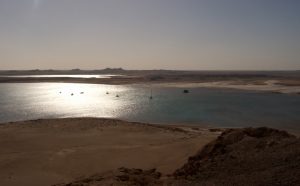

For Ian’s earlier report as mentioned above go to Cruising in Egypt – the Low Down
Southern Egypt
We were advised that supplies would be few and far between South of Hurghada and so we loaded up with food enough for, we hoped, about 12 weeks – enough for a long ocean crossing! We had flour and yeast for bread making and a yoghurt maker (which proved most satisfactory). As we do not have a watermaker on board Jigsaw, seven 19 litre bottles of drinking water were also stowed under the table on the starboard saloon floor. (This balanced the four 22 litre diesel cans lashed to the port rails.)
Hurghada to Qusier: With just 5 other yachts, we finally set off from Hurghada (most of the other rallly yachts opted to spend the rest of the winter there) on 3/1/13 and enjoyed more downwind, if rather rolly, day sailing, stopping at Qusier for the night.
Qusier to Port Ghalib: Then on to Port Ghalib (see Egyptian cruising notes) where we stayed for a few days, exploring the place, doing a little maintenance and getting a few more stores in.
Port Ghalib to Marsa Alam: It is a fairly easy day sail South to Marsa Alam which offers good shelter and plenty of space – but you are not allowed ashore, of course. The entrance is very narrow and, upon leaving the following day, one of our fleet had the first reef encounter, but they were soon pulled off with only superficial damage.
Marsa Alam to Marsa Luli: We sailed on to Marsa Luli, another well-sheltered anchorage where we were windbound for 3 days – rather frustrating and tedious not being allowed ashore, but we did get some good fish from a local boat. After 3 days, the military told us we had to leave, despite our having all the proper documents which showed that we had permission to anchor anywhere. As it happened we were planning to leave anyway, so I don’t know what would have happened otherwise.
The weather had turned rather cool for a week or so before we left Port Ghalib but the temperature soon started to climb and the duvet was stowed away again – was that the winter? – as it turned out, yes!
Mahabis Island: The next stop for us and one other yacht was Mahabis Island where we wiggled in through the reefs to a very attractive anchorage. It is possible to land there (hooray!) as the island is uninhabited other than for ospreys and gulls. (Ospreys, by the way, like to perch on the top of your mast and can play mayhem with mast head instruments!). The sea temperature had crept up from a low of around 22 when we left Hurghada to 26, so snorkelling on the splendid reef was in order.
Dolphin Reef: The following day we motored in no wind down to Dolphin Reef where we joined the other 4 yachts. This is a reasonable anchorage although there is some swell and it is almost impossible to avoid the bommies with your anchor chain. There is a wrecked dive boat inside the reef on the West side – just another reminder of the hazards. However, we did actually get to swim with dolphins which makes it well worth a visit!
Ras Baniyas: From there we sailed to Ras Baniyas which proved a most unsatisfactory anchorage. It is, essentially, a coral garden and not only will you cause significant damage to the coral but you will very likely foul your anchor. Ours was badly fouled and took three hours to clear as the tripping line was sliced by the coral. We were also shouted at, at length, by (we think) the military from the shore but, since they didn’t have a boat, we ignored them. There is a much better, if somewhat out of the way anchorage 12 miles West, not far from Berenice.
Into Sudan
We now approached the Sudanese border, but its location is in dispute and, on the coast, there are 2 borders about 120 miles apart forming a sort of no-mans-land in between. The area is actually under Egyptian control, but we were advised not to attempt to moor along this stretch.
Ras Baniyas to Marsa Umbeila: A passage of 150 miles to Marsa Umbeila, the first anchorage in Sudan, was therefore planned by the rally leader. We were reluctant to go so far in one hit and so decided to overnight on one of the offshore reef anchorages, Dangerous Reef. Unfortunately, this proved less attractive than the Pilot book indicated. Rather than 10m depth, we could not find less than 16 and with the (un-forecast) Southerlies, shelter was poor. So we pressed on overnight and the next day into what became a rare, stiff Southerly. After a 34 hour slog, we made the anchorage just before dusk having burnt half a tank of diesel. The only compensations were numerous dolphins en route, a 4Kg barracuda (fish are plentiful and easy to catch!) and the satisfaction of crossing the Tropic of Cancer.
North Sudan
Marsa Umbeila is a pleasant, deserted, relaxing spot with a good, safe anchorage and a sandy beach. Unlike most of Egypt, there is noticeable wildlife. There are scrubby bushes, scattered trees and ospreys, flamingos, terns and various small birds are easily seen. Mammals are seldom seen, but the shore abounds with tracks of camels, small cloven hooves (goats?) and various other unidentified mammals. (Not to mention bare, human feet – despite the sharp coral fragments and spiky plants.) One set of tracks looked to be a medium-sized cat (15 to 20Kgs I would estimate). We spent a few days here relaxing, walking and windsurfing.
A strong wind forecast came via another boat’s SSB (the only telecommunications there) and the fleet decided to move on before it arrived. We still had the wind ahead but it was only 14 miles to Khor Abu Asal (Marsa Oseif).
Khor Abu Asal: On the approach, the leading yacht was intercepted by the Sudanese military who, quite unnecessarily, fired gunshots. The yacht called up the rally leader on the VHF and said the military were shooting. He replied, “If they are shouting, shout back then.” This elicited the response, “Not shouting, shooting!” – quite hilarious in retrospect. Our valued interpreter, Mustafa (crewing on one yacht), came to the rescue with some well-chosen words and they then became friendly and escorted the leading yachts into the harbour. (It seems that the problem arose simply because they use VHF channel 14 as the hailing channel, rather than 16 (hands up everyone who knew that) and were frustrated at getting no reply.)
A couple of crews were taken ashore and sorted out the paperwork without difficulty (and at no cost as far as I recall). Here we sat out the anticipated blow for 3 days and on the third, it was quiet enough to go ashore and the soldiers gave us a lift the half mile into town in their jeep. The village is small (there is also a refugee camp for those deposed from the disputed area) and mainly consists of wooden huts, but there was a bank (in a sort of Portakabin) where we swapped dollars for Sudanese Pounds (about 5.7 to the dollar) and some of the huts proved to be shops where we were able to buy some fresh fruit.
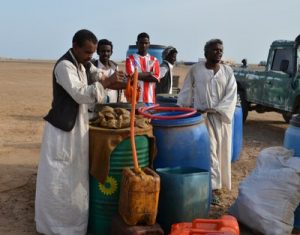

There is even a fuel station which consists of a couple of oil barrels by the roadside. The proprietor pumps the fuel by hand into his litre plastic measuring can (doubtless certified by Weights and Measures) and then siphons it by the “suck and spit” method into your cans. I bought 40 litres at about $0.40 per litre. We were also able to buy ‘phone SIMS at another hut/shop. Many of the locals (all in traditional dress but no women to be seen) have mobile phones but no electricity, and so at the back of the phone “shop”, there is a rack with about 100 mobiles being charged. Bizarrely, the phone shop proprietor gave me a brand new beach umbrella when I bought my SIM.
(At this point, news reached us that there was a curfew in many Egyptian towns, particularly around the Canal, and that, coupled with a reported coup in Eritrea, meant that we were sandwiched in between the trouble spots in Sudan.)
Upon returning to our boats in the late morning, someone suggested on the VHF that we leave for the next good anchorage. We and one other yacht declined as, by the time we arrived, the sun would be low and it would be difficult to see the reefs. (Eyeballing your way into marsas is a must.) The other 4 decided to go.
Khor Abu Asal to Khor Shinab: We had a leisurely sail the next day down to Khor Shinab only to discover that one of our fleet (a steel Van der Stadt) had hit the entrance reef and was severely damaged. They had eventually managed to tow it off and into the anchorage (hitting another reef on the way) and, with the aid of additional pumps it was being kept afloat.
Khor Shinab is a delightful anchorage (totally deserted, as are nearly all – see photo at top). We stayed there a week, much of which was spent repairing the stricken yacht. Leaks were sealed with epoxy putty and patches were welded over the holes (it is amazing what equipment some people carry on the yachts!), the alternator and starter motor were completely stripped and rebuilt, basic electronics were fixed and a jury rudder constructed – not to mention clearing up the mess of a flooded boat. The yacht eventually returned to Turkey but I have been persuaded not to tell how it got there. (There was also a gas explosion and small fire on another yacht – the lesson being when your gas detector fails – fix it! But luckily there was no serious damage and repairs were effected.) I should also mention that there were a couple of sightings of dugong in this marsa as well as in Marsa Umbeila.
After a week, the Rally Leader left for Suakin at short notice and now we were four!
Khor Shinab to Marsa Fijab: We left the following day and planned to overnight at Wreck Recovery Reef (the names tells a tale!) Sadly, the anchorage proved to be full of bommies and, after one yacht fouled their anchor, we decided to move on. Good anchorages are far apart on this stretch and so we settled for an easy overnighter to Marsa Fijab.
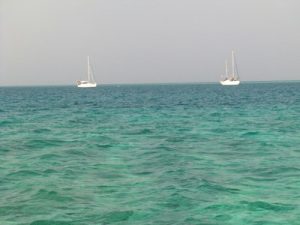

(We had been advised against using Jazirat Bayer but discovered on our return trip that this is an excellent reef anchorage – probably the only good offshore anchorage on this stretch (see photo). The NW entrance is very tricky but the SE entrance is well marked and leads, by a broad channel, to a 7m deep sandy anchorage with very good all-round shelter and the bonus of great snorkelling on the NE reef.)
Marsa Fijab has a tortuous entrance but the Pilot describes it well and it proved very satisfactory even when we had another windy spell. One young man inhabits the place and paddled over to give us some eggs which we didn’t really need but we didn’t have the heart to disappoint him. He invited us to his village (a couple of miles inland but invisible from the coast) but it was too windy to leave the boats. Then someone remembered it was Shrove Tuesday and so the eggs were put to good use with pancakes all round! More bottom scrubbing next morning (fouling is very bad in the Red Sea!) and then we had a gentle sail down to Daror.
Daror: This is a short inlet and so probably too rough in an Easterly and is also rather shallow, but we managed to fit our 4 yachts in.
Daror to Suakin: We left at first light and motor sailed in light winds to Suakin. The inshore route takes you past Port Sudan where you must keep as far to the East (and as near the offshore reefs!) as reasonable to clear the prohibited zones around the oil terminals. Apparently, other yachts have been challenged in this area but we were not.
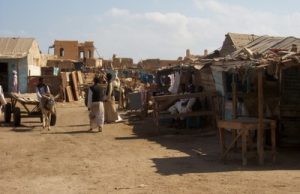

Suakin
Suakin is an ancient port, originally on an island in the harbour but the buildings (built of coral) are now in ruins and the “new town” is on the adjacent mainland. Interestingly, it is reputed to be the last slave trading port in the world, continuing until the late 1940s. The area near the harbour is decidedly ramshackle, even biblical, with rough buildings of stone or wood and donkey carts and tuktuks being used for basic transport.
There is a decent market for fruit and vegetables every day although there is not a great variety of produce and, given the very low earnings here, prices are surprisingly high (about the same as the UK). Fresh meat is also available in the market but there is no refrigeration and it is not always obvious exactly what you are buying. Nonetheless, we bought some “beef” which was fine. It seems that only the staples of bread, fava beans (broad beans) and dates are cheap, so the poorer inhabitants (i.e. most people) can have little variation in their diet. There are beggars around but not in great numbers. Parts of the town do have electricity but ancient diesel engines (of the type you might see exhibited at the Great Dorset Steam Fair) are still much in evidence driving generators and, in the market, a couple of flour mills. There are also shops dealing mainly in tinned and dry goods, based in what might best be described as sheds. There is no chandlery to be had.
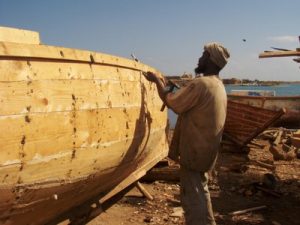

I need hardly add that we (and 2 other yachts) were the only tourists in town. In past years large numbers of circumnavigating yachts would call in, but no more. The locals are very friendly and welcoming and there is none of the Egyptian hassle. We were invited to (and did attend) a local wedding. Men and women were segregated, there was lots of good food (but no cutlery and you should not use your left hand so just try dismembering a roast chicken with one hand only!) and, of course, no alcohol.
Yachts anchor to the SE of Old Suakin which is very secure and has plenty of room. There is nowhere to dock and so all supplies have to be dinghied across.
The agent here, Mohammed, (he drives an ancient Mercedes) is courteous and helpful but one should not lose sight of his mercenary motivation. The basic fee for shore passes etc. (never itemised) was $100 per boat and we were then, unexpectedly, required to pay another $20 for a second week (or part thereof).
He will also supply:-
Diesel (in cans): $0.50 per litre
“Drinking” water (via containers): $10 per 100 litre
“Washing” water: $5 per 100 litre
Internet dongle: $50 (1 month, 1Gb)
Propane: $5 for 3Kg
Currency: 5.6 Sudanese pounds per dollar (bank rate about 5.7)
Note, diesel is about $0.33 at the service station 1Km away; you could probably buy it yourself and arrange transport by donkey cart if you wish.
We enjoyed a stay of 11 days in Suakin and, whilst there, took a bus to Port Sudan – also very interesting. It is possible for yachts to anchor in the harbour, but we saw only a couple of large gulet type boats. Some supplies (particularly meat) are easier to come by and we found a very good restaurant. Again, apart from a few ship’s crews, we were the only foreigners in town and all of the tourist-targeted enterprises seem to have closed down.
We decided to head no further South and the return trip was uneventful but did involve a lot of motor-sailing into stiff headwinds.
I should add one point regarding bank access from Sudan. I checked the balance on my Paypal account whilst in Sudan and it was immediately frozen – and took quite a while to sort out again.
One other curiosity, from Oct 2012 to Oct 2013, Jigsaw saw only one day of rain.
Ian Bray
SY Jigsaw (Moody 38CC) from Christchurch, Dorset, UK.
Currently wintering in Finike, Turkey
Related to following destinations: Port Suakin, Port Sudan, Sudan




